Oman, officially known as the Sultanate of Oman, stands as one of the most strategically located and politically stable nations on the Arabian Peninsula. Under the leadership of His Majesty Sultan Haitham bin Tarik, the country continues to grow steadily in population and economic strength. In 2025, Oman’s population has reached an estimated 5.49 million, shaped by internal development, a young demographic, and a diverse expatriate community. This report explores detailed insights into Oman’s population trends, structure, and distribution based on the latest available data.
Oman Population Statistics 2025 (Key Statistics)
-
The population of Oman in 2025 is 5.49 million
-
The population density is 17.8 per km²
-
The median age is 29.7 years.
-
The total land area is 309,500 km²
-
Muscat is the capital city of Oman.
-
The male population is 3.43 million, while the female population is 2.06 million
-
The population in urban areas is 4.99 million, while the population in rural areas is 0.60 million
-
Oman is an Islamic nation, with 4.99 million Muslims residing there
-
Among the Omani cities, Muscat has the highest population, with 797,000 people.
Oman Population Statistics 2025 (Infographics)

Population According to Different Sources
|
worldometers.info |
5.40 Million |
|
worldpopulationreview.com |
4.37 Million |
|
Statisticstimes |
5.43 Million |
|
Statista |
5.50 Million |
|
populationpyramid.net |
5.49 Million |
|
Macrotrends |
4.78 Million |
|
Datareportal |
5.40 Million |
Worldometers and Datareportal both report 5.40 million, which aligns with mid-year global projections. Statista and populationpyramid.net provide slightly higher estimates of 5.50 and 5.49 million, likely based on the UN’s forecast for 2025. Statisticstimes is close, at 5.43 million. Macrotrends shows a lower figure of 4.78 million, while Worldpopulationreview.com gives the lowest estimate at 4.37 million.

General Information
|
Population Density |
17.8 per km² |
|
Median Age |
29.7 years |
|
Total Land Area |
309,500 km² |
|
Capital City |
Muscat |
Oman covers a large land area of 309,500 square kilometres, placing it among the biggest countries in the Arabian Peninsula. Despite this size, it has a low population density of around 17 people per square kilometre, mainly due to its wide deserts and rugged mountains.
The country has a young population, with a median age of 29.7 years, which signals a growing need for jobs, education, and long-term planning. Muscat, the capital, serves as both the political centre and a vibrant cultural spot. Known for its mix of old Omani charm and modern development, Muscat’s location by the Gulf of Oman has long played a key role in shaping the country’s trade and economy.

Demographics Of Oman 2025
Oman’s 2025 demographics reveal a nation with a young and rapidly urbanising population. With a majority of residents concentrated in working-age groups and urban centres, Oman faces both opportunities and challenges in planning for sustainable growth. The data below provides a closer look at the population breakdown by gender, age, location, nationality, and religion.
Gender Split
|
Male |
62.41% |
3.43 M |
|
Female |
37.59% |
2.06 M |
Oman’s population in 2025 shows a clear gender imbalance, with men making up about 62.41% (3.43 million) and women 37.59% (2.06 million).
Despite national efforts to support economic diversity and increase women’s participation, the overall split continues to reflect the impact of labour-driven migration.
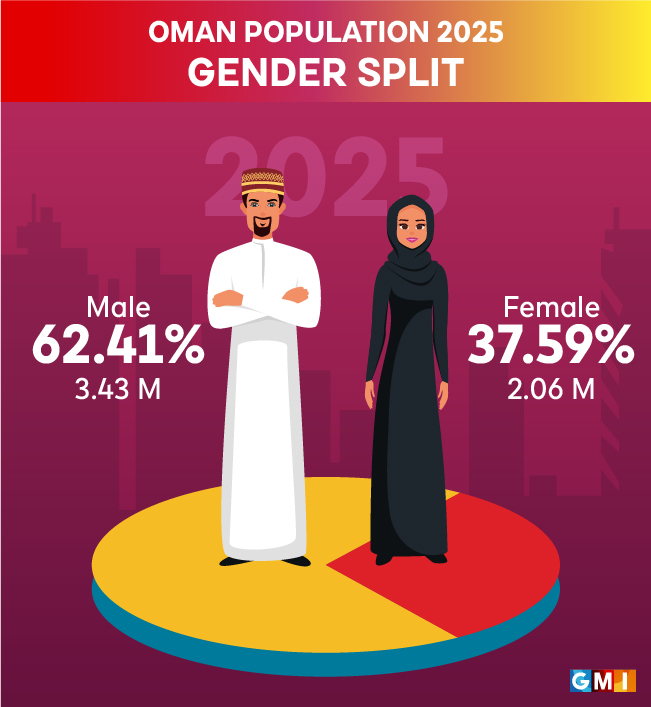
Oman Population by Age
|
Age Group |
Percentage Population |
Population (in Million) |
|
0-14 years |
24.32% |
1.34 |
|
15-24 years |
13.65% |
0.75 |
|
25-54 years |
55.24% |
3.04 |
|
55-64 years |
4.10% |
0.22 |
|
65 years and over |
2.69% |
0.14 |
Oman’s 2025 population is largely concentrated in the working-age group of 25 to 54 years, making up 55.24% or approximately 3.04 million people. Children aged 0 to 14 years account for 24.32%, which equals around 1.34 million. Teenagers and young adults between 15 and 24 years make up 13.65%, or roughly 0.75 million. The older adult group aged 55 to 64 years comprises 4.10% (about 0.22 million), while seniors aged 65 and over represent just 2.69%, which is around 0.14 million.
The relatively small proportion of the population aged 65 and above suggests that Oman currently faces fewer challenges related to an ageing population compared to many other countries. However, the significant youth and working-age segments present opportunities and challenges in areas such as employment, education, and healthcare services.
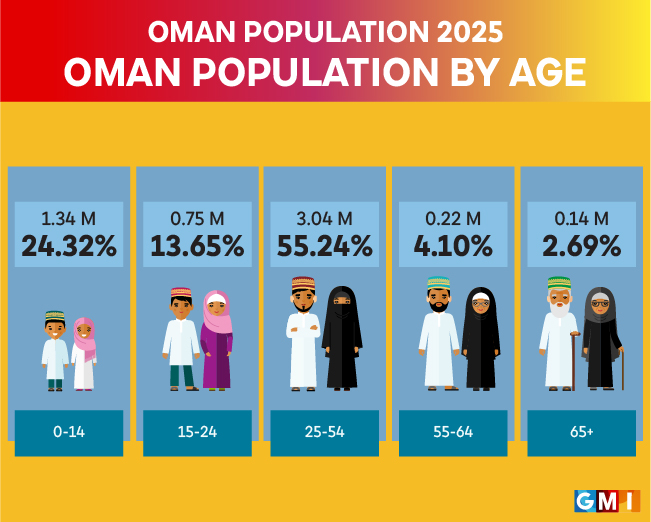
Oman Population by Gender
|
Age Group |
Men Pop (in millions) |
Women Pop (in millions) |
|
0-14 years |
0.68 |
0.65 |
|
15-24 years |
0.44 |
0.31 |
|
25-54 years |
2.09 |
0.94 |
|
55-64 years |
0.14 |
0.09 |
|
65 years and over |
0.07 |
0.08 |
The data indicates a higher proportion of males within Oman’s working-age population. The 0–14 age group exhibits a near balance between males (0.68 million) and females (0.65 million), whereas the 15–24 and 25–54 age groups show a greater number of males, with 2.09 million men compared to 0.94 million women in the largest cohort.
In the 55–64 age group, the male population stands at 0.14 million compared to 0.09 million females. Among those aged 65 and above, females slightly outnumber males, with 0.08 million women versus 0.07 million men.
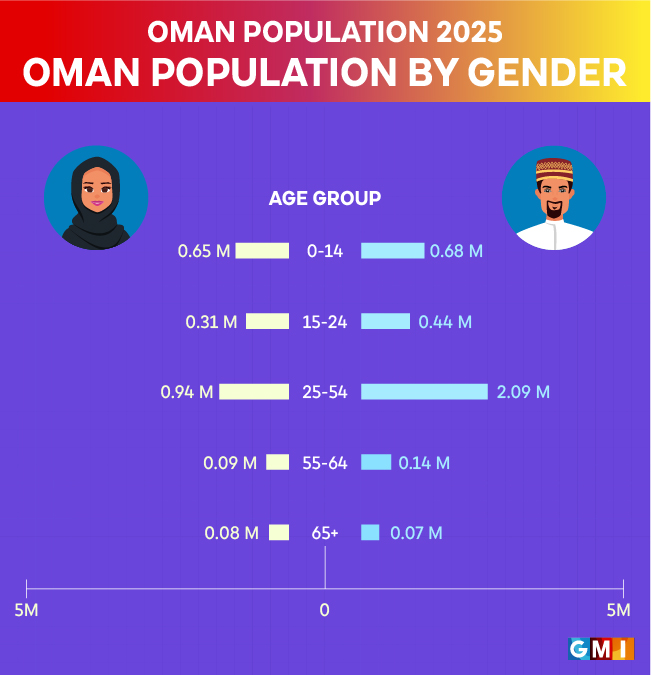
Oman Population 2025 (Urban V/s Rural)
|
Area Type |
Percentage |
Population (In Million) |
|
Urban |
89.20% |
4.99 |
|
Rural |
10.80% |
0.60 |
Oman’s population is largely urban, with 89.2%—around 4.99 million people—living in cities, while only 10.8%, about 0.60 million, reside in rural areas. This strong urban presence is mainly due to economic activities being centred in cities like Muscat.
Despite their smaller size, rural communities remain important, supporting agriculture and traditional crafts that help preserve Oman’s cultural heritage and contribute to food security.
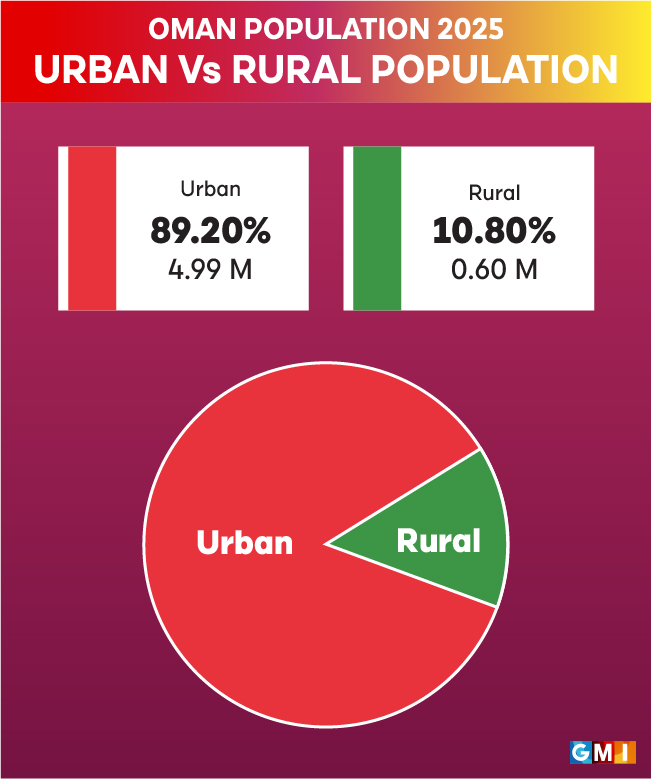
Expat vs Omani Population 2025
|
Group |
Percentage |
Users (in Million) |
|
Omani Citizens |
56.70% |
3.17 |
|
Expatriates |
43.30% |
2.42 |
Oman’s 2025 population is composed of 56.70% Omani citizens (3.17 million) and 43.30% expatriates (2.42 million).
The government continues to promote localisation efforts through the Omanisation policy, which aims to create more job opportunities for citizens and gradually reduce dependency on expatriate labour. Despite this, expatriates still form a substantial part of the demographic structure due to their role in economic development and key infrastructure projects.

Oman Population by Nationality 2025
|
Nationality |
Population |
|
Oman |
2,505,369 |
|
India |
766,735 |
|
Bangladesh |
718,856 |
|
Pakistan |
268,868 |
|
Egypt |
46,970 |
|
Philippines |
45,213 |
|
Uganda |
20,886 |
|
Sri Lanka |
20,003 |
|
Tanzania |
17,077 |
|
Nepal |
16,580 |
|
Indonesia |
14,155 |
|
Ethiopia |
13,572 |
|
Total Non Omanis |
2,054,594 |
In 2025, Oman’s population includes an estimated 2,505,369 Omani citizens and 2,054,594 non-Omani. Among expatriates, the largest communities are from India (766,735) and Bangladesh (718,856), followed by Pakistan (268,868).
Other notable expatriate groups include nationals from Egypt (46,970), the Philippines (45,213), and Uganda (20,886). Smaller but still significant communities come from Sri Lanka (20,003), Tanzania (17,077), Nepal (16,580), Indonesia (14,155), and Ethiopia (13,572).
This diverse mix of nationalities reflects Oman’s open labour market and its strong regional ties. While South Asian workers dominate manual labour and service roles, other groups support sectors such as healthcare, education, and domestic work. Their presence also adds to the multicultural social landscape of urban Oman.
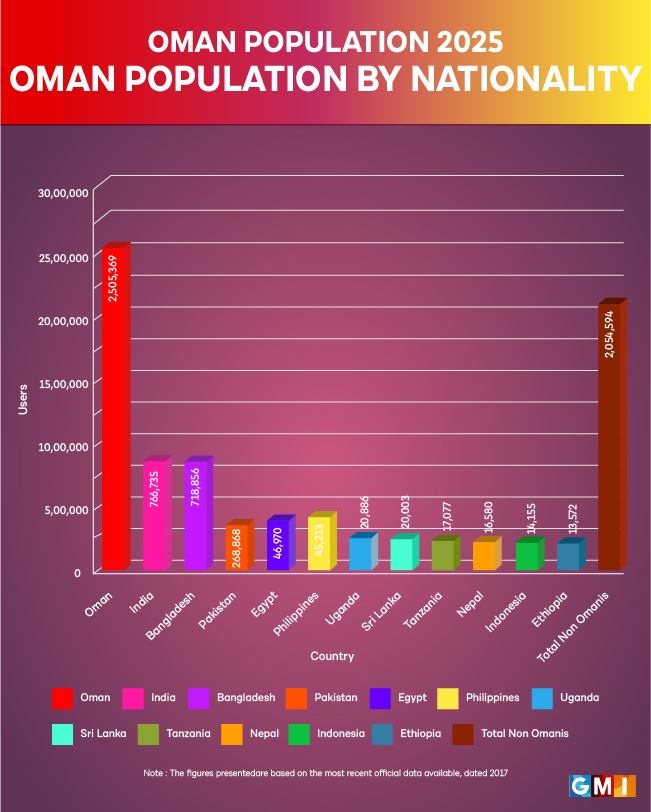
Oman Population By Year
|
Year |
Population (in Million) |
|
2025 |
5.49 |
|
2024 |
4.71 |
|
2023 |
4.64 |
|
2020 |
4.54 |
|
2015 |
4.19 |
|
2010 |
2.88 |
|
2005 |
2.52 |
|
2000 |
2.34 |
Oman’s population has steadily grown from 2.34 million in 2000 to an estimated 5.49 million in 2025. Significant increases can be seen between 2010 and 2015, when the population rose sharply from 2.88 million to 4.19 million. By 2023, it reached 4.64 million, climbing further to 4.71 million in 2024. This steady growth reflects improved healthcare, economic development, and a rising number of expatriate workers contributing to the nation’s progress.
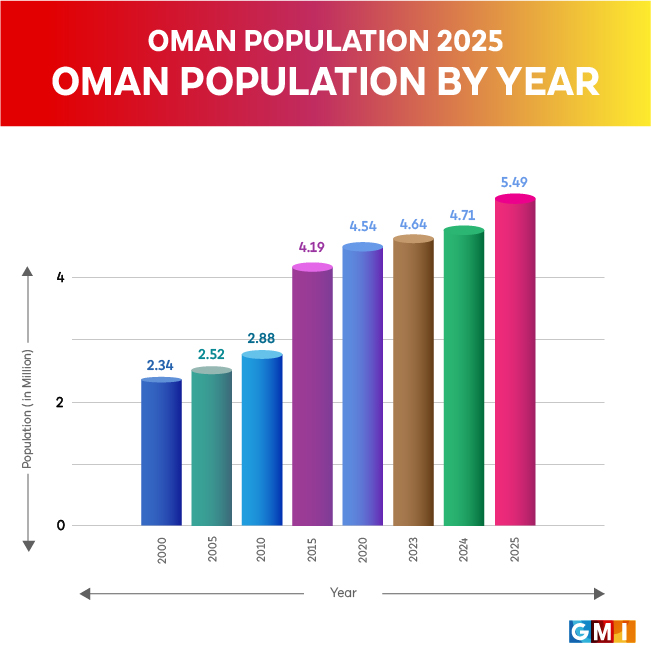
Oman Population by Religion
|
Religion |
Percentage |
Users (in Million) |
|
Islam |
90.90% |
4.99 |
|
Hinduism |
4.70% |
0.26 |
|
Christianity |
2.90% |
0.16 |
|
Other/Small |
0.80% |
0.04 |
|
Buddhism |
0.50% |
0.03 |
|
Nonreligious |
0.20% |
0.01 |
The vast majority of Oman’s population adheres to Islam, accounting for 90.9% or approximately 4.99 million people. Hinduism is the second-largest religious group, representing 4.7% (around 0.26 million), followed by Christianity at 2.9% (about 0.16 million).
Smaller communities include those classified as “Other/Small” religions, making up 0.8% (0.04 million), Buddhism at 0.5% (0.03 million), and individuals identifying as non-religious, who constitute 0.2% (0.01 million) of the population. This religious diversity largely reflects Oman’s multicultural expatriate population alongside its Islamic heritage.
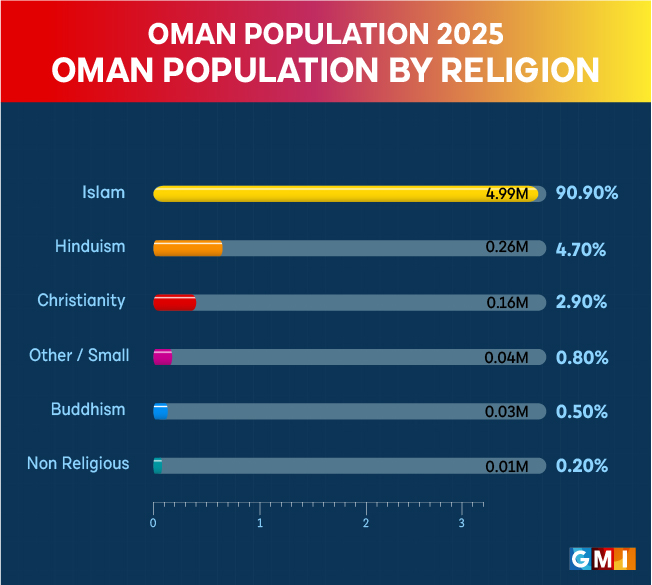
Oman Population by City
|
City |
Population |
|
Muscat |
797,000 |
|
Seeb |
237,816 |
|
Salalah |
163,140 |
|
Bawshar |
159,487 |
|
Sohar |
108,274 |
|
As Suwayq |
107,143 |
|
`Ibri |
101,640 |
|
Saham |
89,327 |
|
Barka’ |
81,647 |
|
Rustaq |
79,383 |
The 2025 population data for Oman’s major cities shows a clear concentration in the capital, Muscat, with 797,000 residents—more than triple the population of the next largest city, Seeb (237,816). Other cities like Salalah and Bawshar come next, with 163,140 and 159,487 residents, respectively, showing their importance as southern and suburban hubs.
Cities like Sohar (108,274), As Suwayq (107,143), and `Ibri (101,640) reflect steady population levels just above 100,000. Meanwhile, Saham (89,327), Barka’ (81,647), and Rustaq (79,383) form the lower tier of the top ten, still contributing notably to Oman’s urban landscape. The figures suggest a population pattern centered around Muscat and supported by regional urban clusters.
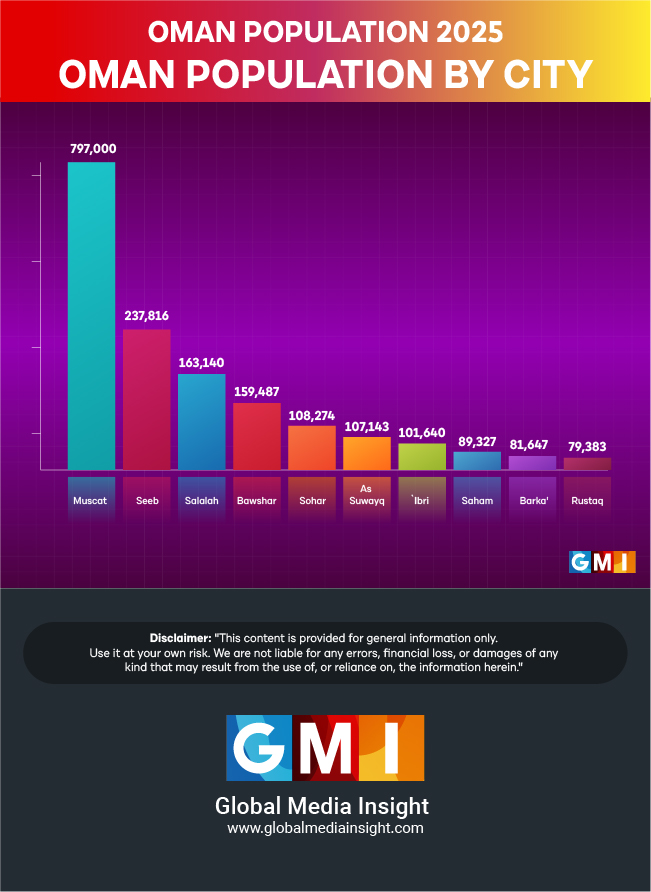
Disclaimer: This content is provided for general information only. Use it at your own risk. We are not liable for any errors, financial loss, or damages of any kind that may result from the use of, or reliance on, the information herein.
Oman Population Statistics 2024 (Infographics)

Population According to Different Sources
|
worldometers.info |
4.69 Million |
|
worldpopulationreview.com |
4.69 Million |
|
Datareportal |
4.68 Million |
|
Statista |
5.26 Million |
|
populationpyramid.net |
4.71 Million |
|
Macrotrends |
4.71 Million |
When we search for Oman’s population in 2024, we get different statistics from different sources.
While worldometers.info and worldpopulationreview.com suggest a population of 4.69 million people, Datareportal records it as 4.68 million people.
Similarly, populationpyramid.net and Macrotrends record a population of 4.71 million.
The highest population is recorded by Statista which is 5.26 million.
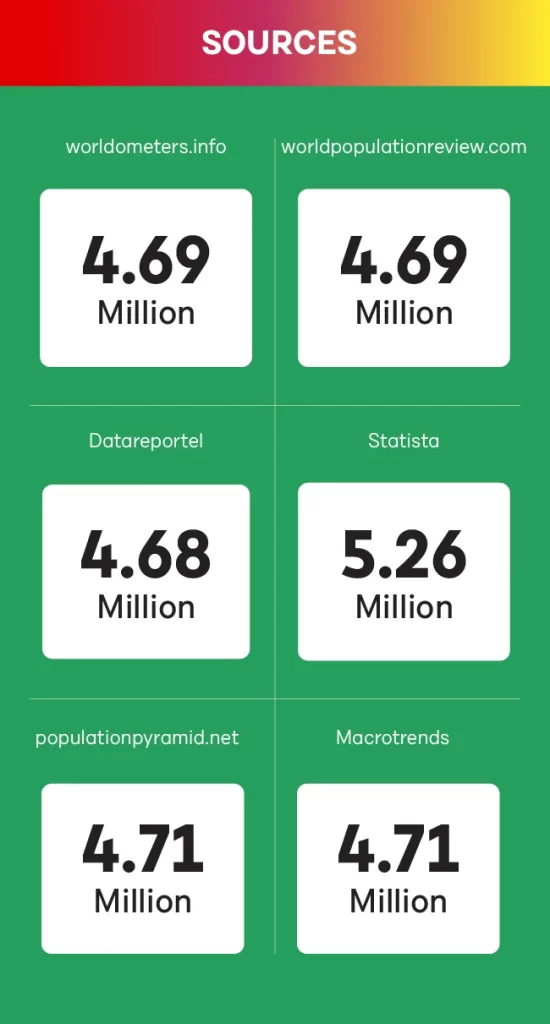
General Information
|
Population Density |
15.1 per Km2 |
|
Median Age |
29.2 Years |
|
Total Land Area |
309,500 Km2 |
|
Capital City |
Muscat |
Oman, situated in the Arabian Peninsula, uses Arabic as its official language and conducts transactions using the Rial (OMR) as its official currency.
Governed by Sharia law, the country reveres the Sultan’s authority as absolute, shaping its legislative landscape.
Despite its vast land area of 309,500 square kilometers and a low population density of only 15.1 individuals per square kilometer, Oman’s median age is 29.2 years.
This indicates potential opportunities and challenges in its socio-economic development journey.
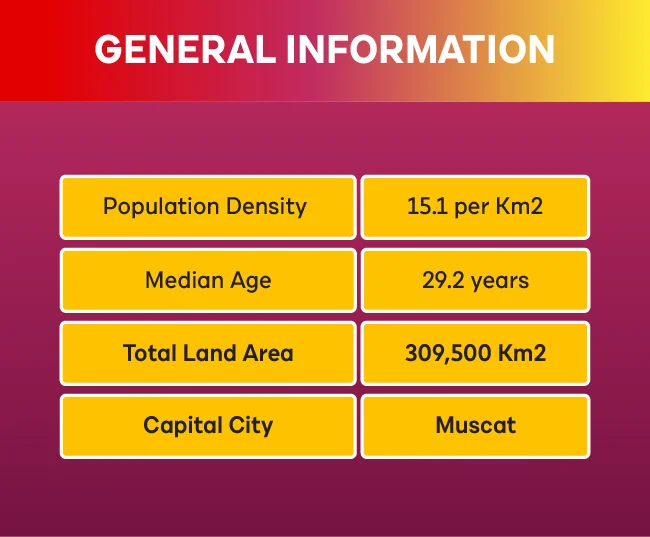
Demographics of Oman 2024
When we look at the demographics of Oman, we come across several interesting facts.
Let’s analyse a few:
Gender Split
|
Gender |
Percentage |
Population |
|
Male |
60.54% |
2.85 Million |
|
Female |
39.46% |
1.86 Million |
With males making up 60.54% (around 2.85 million) and females making up 39.46% (approximately 1.86 million) of the population, Oman’s demographic landscape shows a predominantly male society.
The higher percentage of men in Oman may stem from labor migration, especially in industries like construction and oil.
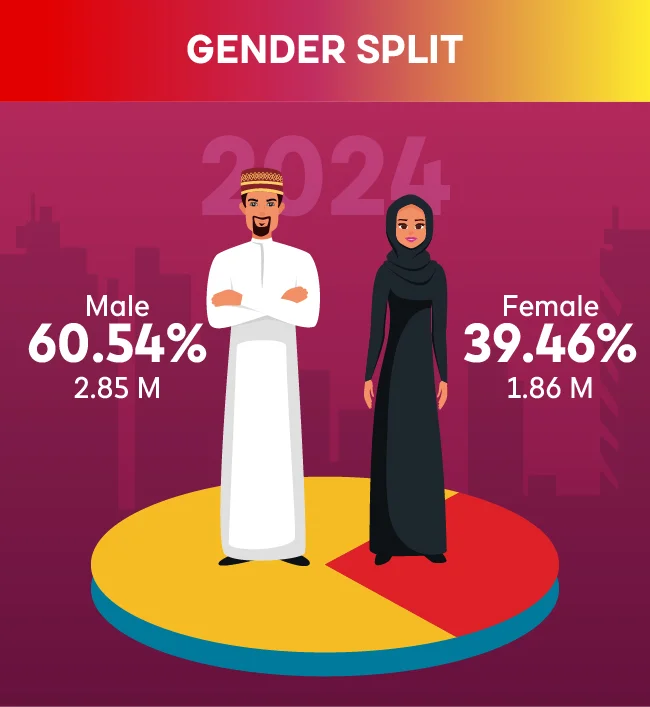
Oman Population By Age
|
Age Group |
Percentage |
Population |
|
0-14 Years |
26.82% |
1.26 Million |
|
15-24 Years |
12.27% |
0.58 Million |
|
25-54 Years |
53.64% |
2.53 Million |
|
55-64 Years |
4.38% |
0.21 Million |
|
65 Years and Over |
2.90% |
0.14 Million |
Oman’s population distribution reveals a significant proportion of its population in the working-age group, with 53.64% (around 2.53 million) aged between 25 and 54 years.
The younger age groups, 0-14 years and 15-24 years, collectively account for 39.09% (approximately 1.84 million) of the population, indicating a considerable youth demographic that will shape Oman’s future socio-economic landscape.
We can see that the older age group has a lower representation in the Oman population.
For example, the age group of 55-64 years occupies 4.38% of the population, which is 0.21 million.
65 years and older occupy only 2.90% of the population, which is 0.14 million.
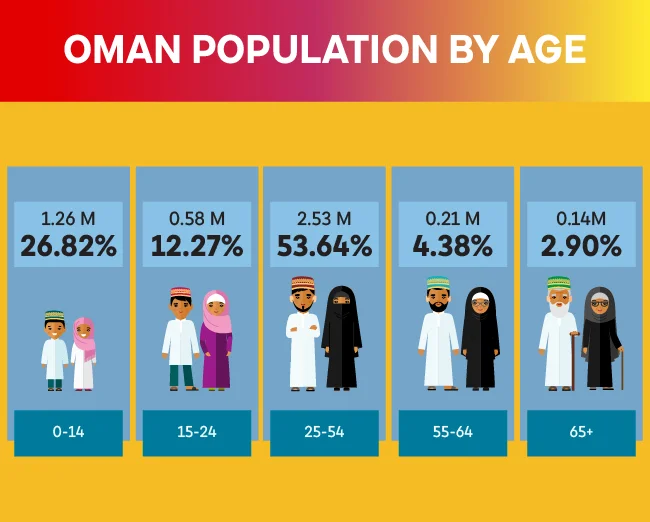
Oman Population By Gender
|
Age Group |
Men Population |
Women Population |
|
0-14 Years |
0.64 Million |
0.62 Million |
|
15-24 Years |
0.31 Million |
0.27 Million |
|
25-54 Years |
1.71 Million |
0.82 Million |
|
55-64 Years |
0.13 Million |
0.08 Million |
|
65 Years and Over |
0.07 Million |
0.07 Million |
In Oman, the population distribution by age and gender shows that men outnumber women in most age groups, particularly in the 25-54-year category, where the male population is 1.70 million and the female population is only 0.82 million.
As age increases, there is a more balanced distribution in men’s and women’s ratios.
For example, in the category of 55-64 years, men account for 0.13 million, and women account for 0.08 million.
Surprisingly, we see that in the 65-year-above age group, both men and women have the same number, 0.07 million each.
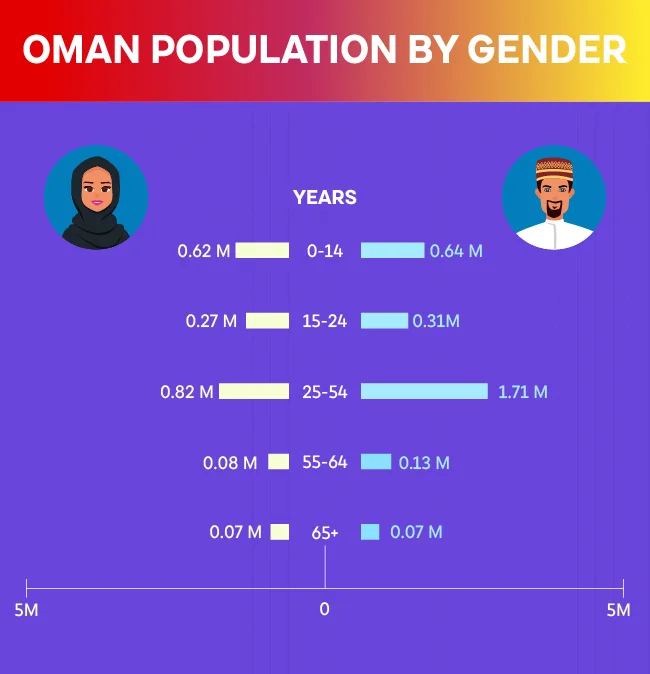
Oman Population 2024 (Urban V/s Rural)
|
Urban |
88.60% |
4.17 Million |
|
Rural |
11.40% |
0.54 Million |
The majority of Oman’s population resides in urban areas, accounting for 88.60% (approximately 4.17 million).
While the rural population comprises 11.40% (around 0.54 million), reflecting a significant urbanization trend in the country.
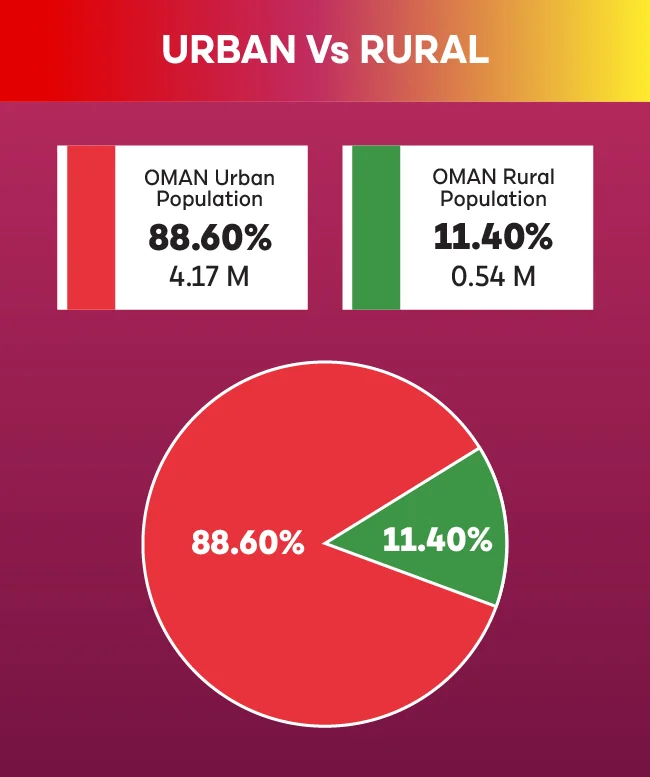
Oman Population By Year
|
Year |
Population |
|
2024 |
4.71 Million |
|
2023 |
4.64 Million |
|
2020 |
4.54 Million |
|
2019 |
4.60 Million |
|
2018 |
4.60 Million |
|
2017 |
4.54 Million |
|
2015 |
4.19 Million |
|
2010 |
2.88 Million |
|
2005 |
2.52 Million |
|
2000 |
2.34 Million |
Oman’s population has undergone significant growth over the past two decades, reflecting both natural increase and migration trends.
In 2000, the population stood at 2.34 million, experiencing a steady rise to 2.52 million by 2005.
Subsequent years saw continued expansion, with the population reaching 4.19 million in 2015 and 4.54 million in 2017.
Despite slight fluctuations, the overall trend remained upward, with the population reaching 4.60 million in both 2018 and 2019.
By 2020, it had decreased to 4.54 million, followed by a slight increase to 4.64 million in 2023 and further growth to 4.71 million in 2024.

Oman Population By Religion
|
Religion |
Percentage |
Population |
|
Islam |
90.90% |
4.28 Million |
|
Hinduism |
4.70% |
0.22 Million |
|
Christianity |
2.90% |
0.14 Million |
|
Other/Small |
0.80% |
0.04 Million |
|
Buddhism |
0.50% |
0.02 Million |
|
Non Religious |
0.20% |
0.01 Million |
Oman’s religious landscape is predominantly Islamic, with 90.90% of the population adhering to Islam, accounting for approximately 4.28 million individuals.
Hinduism, Christianity, and Buddhism represent smaller religious communities, comprising 4.70% (0.22 million), 2.90% (0.14 million), and 0.50% (0.02 million) of the population, respectively.
Additionally, there are smaller groups of individuals categorized as “Other/Small” religions, constituting 0.80% (0.04 million) of the population, while those identifying as non-religious make up 0.20% (0.01 million).
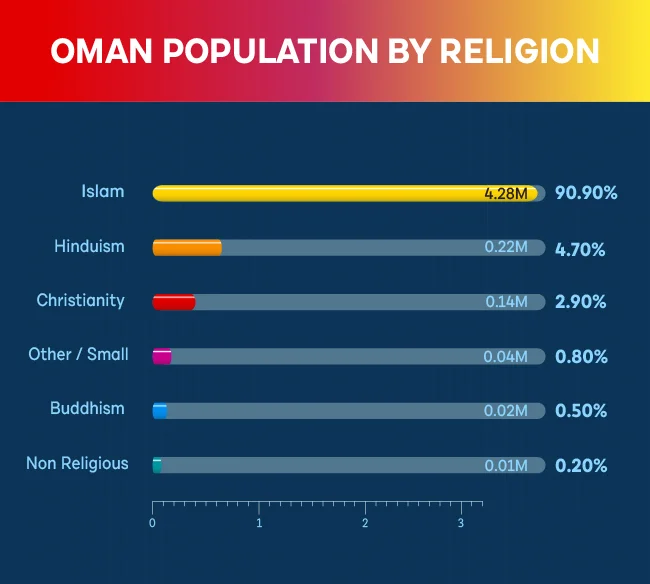
Oman Population by City
|
City |
Population |
|
Muscat |
797,000 |
|
Seeb |
237,816 |
|
Salalah |
163,140 |
|
Bawshar |
159,487 |
|
Sohar |
108,274 |
|
As Suwayq |
107,143 |
|
`Ibri |
101,640 |
|
Saham |
89,327 |
|
Barka’ |
81,647 |
|
Rustaq |
79,383 |
Muscat stands as the most populous city, with approximately 797,000 residents.
Muscat’s status as the capital and economic hub attracts a significant portion of the population.
The second and third positions are occupied by Seeb, with 237,816 residents, and Salalah, with 163,140 residents.
Other significant urban centers include Bawshar (159,487), Sohar (108,274), As Suwayq (107,143), `Ibri (101,640), Saham (89,327), Barka’ (81,647), and Rustaq (79,383), each contributing to the country’s urban fabric and socio-economic dynamics.

Oman Population by Nationality 2024
|
Nationality |
Population |
|
India |
766,735 |
|
Bangladesh |
718,856 |
|
Pakistan |
268,868 |
|
Egypt |
46,970 |
|
Philippines |
45,213 |
|
Uganda |
20,886 |
|
`Sri Lanka |
20,003 |
|
Tanzania |
17,077 |
|
Nepal |
16,580 |
|
Indonesia |
14,155 |
|
Ethiopia |
13,572 |
|
Other Countries |
259,258 |
Currently, Oman is home to a multicultural expatriate population making a substantial impact on the nation’s demography.
The largest is the Indian community, which consists of 766,735 people, attributed to the country’s economic and cultural relations with Oman.
Bangladeshis come second with 718, 856 followed by Pakistanis with 268, 868.
Another major group of the expatriate population includes Egyptians, 46,970 and Filipinos, 45,213.
Other minorities include Ugandans and Sri Lankans who are 20,886 and 20,003 in number respectively.
The Tanzanian community is comprised of 17,077 people, and Nepalis contribute 16,580 people to the mix.
The Indonesians and Ethiopians are among the diverse workers present with numbers of 14,155 and 13,572 respectively.
Besides, 259,258 people from other countries contribute to the multicultural diversity of the Omani population.
These expat communities are thus beneficial to the development of Oman’s society and provide evidence to support Oman’s status as a country that attracts talent and human capital from across the globe.
For a broader understanding of how Oman’s demographic diversity fits within the region, you can explore our comprehensive GCC population statistics.
Disclaimer: This content is provided for general information only. Use it at your own risk. We are not liable for any errors, financial loss, or damages of any kind that may result from the use of, or reliance on, the information herein.

